I don't have a scanned copy of the cover of this book because I bought it as an e-book on the Taunton website. If you wait for a sale, you can purchase this e-book for half off.
Title: Easy Guide to Sewing Tops & T-Shirts
Author: Marcy Tilton
ISBN: 1561582395
Publication Date: 1998
Pages: 128
Overall impression, I like this book and would recommend it to others. I consider this book a must have if you want to take your sewing to the next level. If you want quick and easy, this may not be required reading. Many of her suggestions for getting the most out of your fabric or pattern design will add to your construction time. I learned quite a bit and most of the book is very detailed. There were a few instances where I found Marcy's description of a technique a bit inadequate (for my understanding anyway, you may think she was very clear). There are more photos than drawings but I wish there was an illustration for each step when she is explaining a technique. Usually there are only 2 or 3 photos for a 7-step process and sometimes I found myself scratching my head wondering how she got from picture 2 to picture 3. She does a great job giving you ideas on how to venture away from the basic pattern construction, such as manipulating a fabric to showcase it's best properties. I particularly enjoyed the section on changing on-grain patterns to a bias grain. She goes into great detail about which fabrics are best for bias work and how the pattern will need to be modified. For those of you thinking "Why bother?", read the book. Her description helps you realize that you don't need to purchase a new pattern for each design detail you like. Have a handful of patterns you've used in the past quite successfully. Now put a spin on the design, add an interesting neck binding, cut the fabric on the bias, embellish the fabric, and now your tried-and-true pattern looks like a completely different top.
The construction chapters are broken down by woven vs. knit top construction, which is very helpful. She starts the discussion with a list of steps and then goes into great detail on the following pages. She gives recommendations for fabrics for those just starting out. For instance, silks are lovely to wear but not a beginner fabric. Rayons, although nice to touch, are more difficult to manipulate on the bias so save those for when you are more experienced.
Marcy talks a lot about "staystitch-plus" (or easestitch-plus) as a method of easing a longer section of fabric to match a shorter section of fabric as you sew. I had never heard of this term before so I had to read the description of this several times. (I found a decent description of it here in regards to hems--scroll one-third of the way down the page.) I can see how this would be a great way to set-in sleeves and such. I find the technique confusing regarding topstitching (and Marcy recommends using it in topstitching quite a bit). Wouldn't that give you bumpy topstitching? With natural fibers, you could probably steam out the bumps and give it a nice look but I still don't understand why you would want to ease a hem's topstitching. Ease the hem's raw edge before pressing the hem and topstitching, that I get but easing the topstitching?? Maybe that is what Marcy meant but I've re-read that section several times (and she mentions it elsewhere and I've re-read those as well) and it just doesn't sound right to me. If you follow the link I gave above (link here), you'll see this author specifically says not to staystitch-plus a hem's topstitching, as in a turn-and-stitch hem. Anyway, I haven't tried to use this technique on a hem yet so take my opinion with a grain of salt.
One technique I do disagree with (and have ample experience with) is Marcy's recommendation to not use double-needle stitching on hems for double knits. I have done this successfully with every double knit I've used (mostly poly blends or rayon) and I've never had any stretching or rippling that she warns will happen. (Perhaps a silk double knit would ripple with the double-needle topstitching.) I have, however, had skipped stitches and thanks to her recommendations for needles when sewing knits, I now know why. She does a fantastic job explaining how to add a strip of interfacing to a hem. I thought you fused the interfacing to the hem allowance, pressed up the hem and then stitched. She recommends stitching the interfacing to the hem first (interfacing is fusible side up, so nonsticky side is stitched to wrong side of fabric), press up the hem (which fuses the interfacing to secure the hem), flip to the right side of the fabric and topstitch. With the hem already fused in place, no slippage while you sew. So simple but very handy.
Marcy's section on use of the bias grain is fantastic as well. She even shows you how to use the bias (with center seam) on a sleeve to make an interesting effect with a striped fabric. It is stunning and I will have to try that some time soon. My only quibble with this section of the book is the recommendation to stretch the fabric as you sew a bias seam. She says you stretch the fabric as much as possible while you stitch and then steam it flat. I've not had luck with this in the past but perhaps I was being too gentle with my fabric. I took a couture sewing class with Susan Khalje last summer and she showed us a great way to sew bias seams stitched in short segments (described very clearly in each of her books). This method doesn't sound like it would work but one of the ladies in the class was sewing silk with bias seams and it looked great. I've never seen a bias seam look so good before. It hung beautifully, not a ripple in sight. I will have to compare these 2 techniques and see which I like better.
The best section of this book is the "pattern proofing" section. She spends an entire chapter talking about little tweaks to make to your pattern before you cut your fabric. Adding a little extra width and length at the bust area for large busts. Curving the shoulder and sleeve hems to hang nicely. Those are just a few but they make sense because fabric drapes and your body isn't flat like pattern paper. These little tweaks help take a flat pattern to a wearable garment that works with the body's contours instead of against it. I probably spent the most time reading this one chapter alone.
This book was a great read, and even a fast read because it was so enjoyable to read. Even though I disagree with a few of the recommendations, I found the majority of her recommendations to be very helpful. The nice thing about sewing is the fact that there is usually more than one way to accomplish a task. You find what works best for you and use that, even if other experts say that technique won't give you the best results.
A Seam A Day
As of December 2012, this blog is no longer being updated or maintained.
Wednesday, June 15, 2011
Sunday, June 12, 2011
We deserve better
We meaning you and I and every other person that has amassed a large collection of books and DVDs, spent hours on the internet reading tutorials, and spent hundreds of dollars for just a single class all in the name of improving our sewing skills. We deserve better. Our skills and years of experience are worth more than just minimum wage. I'm referring of course to the practice of charging very little for sewing lessons or those that are paid peanuts to teach sewing classes at retail stores. We deserve better.
I am still unemployed and it makes me a little crazy and a little desperate. To maintain my sanity, I decided to start teaching some sewing classes. I love sewing and figured this would be a great way to earn a little extra money and keep me out of trouble while I look for a decent job. Instead, I've put myself in a very uncomfortable situation and I've got a massive headache. I applied for an independent contractor position with JoAnn Fabrics. Independent contractors aren't paid by the store. The store collects the fees for the sewing classes, maintains a classroom and equipment, and coordinates the registrations for you. You make a sample and teach the class. JoAnn supplies the pattern but you supply the fabric and notions. (You do get to keep the sample, you can make it in your size and you can use whatever fabric you like.) JoAnn's gets 40% of the class fee and you get 60%. I admit 40% is rather high for the store but I decided it was still worth my time if at least 5 people signed up for the class. Besides, JoAnn is supplying the machines, irons, ironing board, etc. (per the Education Coordinator). Each month the store hosts an open house to introduce the instructors to the customers. The instructors don't get paid for this time but they did give me two "20% off your entire purchase coupons." Hmm, coupons only have value if you buy something to use the coupon on.
I showed up for the first open house yesterday and when I walked through the door, I saw the "50% off select classes" sign. I asked the Education Coordinator, "does that include my classes?" Well of course it does and now I only get 60% of the 50% the customer paid for the class. So let's do some math:
$55/class, 4 hours total class time = $13.75/hour
Customer paid for the class at an Open House so hourly rate is now $6.88.
Per hour: JoAnn's share is $2.75 and mine is $4.13
According to the other instructors, usually only 2-3 people sign up for a class.
My hourly rate for 2-3 people is $8.26-$12.39
I must pay the self-employment tax quarterly, which is reduced for 2011 only: 10.4% Social Security and 2.9% Medicare. I must pay the federal taxes annually--depends on your total annual income so I'll leave this out of the equation.
Hourly rate for 2-3 people (after taxes): $7.16 - $10.74/hour
Factor in costs of fabric, notions, and gas to/from store.
This can vary by project but I'll use my cheapest sample as a guide.
Extra costs:
2 yards of knit fabric from stash: $4.00/yard x 2 yards plus sales tax = $8.74
1 yard of 3.25-inch lace trim I had to purchase to make the shirt the way JoAnn's wanted it: $3.99/yard x 10% American Sewing Guild discount plus sales tax = $3.92
Small spool of thread from stash: $1.33 plus tax = $1.45
Gas to travel to store for 2 class sessions and the unpaid Open House = 3.5 miles one-way x 3 round trips x $4.00/gallon with 22 mpg = $3.82
Total extra costs: $17.93
Hourly rate after taxes and extra costs = $2.68 - $6.26/hour
(FYI...U.S. minimum wage is currently $7.25/hour.)
I forgot the best part. JoAnn's has sewing machines but requests that customers use their own. They supply ONE iron and a crappy desktop half-size ironing board. Classes are only conducted during normal store hours so it really doesn't cost the store anything but the credit card charges for accepting customer payments. For all this, they get 40%. I bust my hump to meet all their demands, including not getting paid for any JoAnn employees that wish to take my class, and I get get a whopping $2.68-6.26/hour! Some may call me a snob but I've spent years reading books, watching DVDs, taking classes, learning wherever and whenever I can. My time is worth more than $6.26 per hour. I may not be certified or hold a fashion design degree, but my skill set is hardly minimum and therefore worth more than minimum pay.
Now some of you are probably saying, "It serves her right. She should have asked questions." I did ask questions. I asked lots of questions. I was told half-truths. I feel that the Education Coordinator deceived me by leaving out crucial details, such as "your classes are offered half off once a month, which means you get only half the pay we promised you," or "we don't really supply machines and your ironing board is barely bigger than a postage stamp."
Needless to say, I'm headed to JoAnn's today to tell them to take a hike. This lousy deal isn't store policy either; it's a corporate policy. I'm so disgusted that I am seriously considering never shopping at JoAnn's again. I don't buy fabric there anyway. I just shop the pattern and notion sales. I'd rather give that money to someone else. Someone who isn't trying to screw the little guy.
So in conclusion, next time someone says they'll pay you to teach a sewing class, consider your skills, experience, and added costs before you agree to it. Chances are they are receiving a much better deal than you are. Your skills are worth something and if you don't insist on proper compensation, the person receiving your services won't place any real value on your services. You are worth more.
--Julie
I am still unemployed and it makes me a little crazy and a little desperate. To maintain my sanity, I decided to start teaching some sewing classes. I love sewing and figured this would be a great way to earn a little extra money and keep me out of trouble while I look for a decent job. Instead, I've put myself in a very uncomfortable situation and I've got a massive headache. I applied for an independent contractor position with JoAnn Fabrics. Independent contractors aren't paid by the store. The store collects the fees for the sewing classes, maintains a classroom and equipment, and coordinates the registrations for you. You make a sample and teach the class. JoAnn supplies the pattern but you supply the fabric and notions. (You do get to keep the sample, you can make it in your size and you can use whatever fabric you like.) JoAnn's gets 40% of the class fee and you get 60%. I admit 40% is rather high for the store but I decided it was still worth my time if at least 5 people signed up for the class. Besides, JoAnn is supplying the machines, irons, ironing board, etc. (per the Education Coordinator). Each month the store hosts an open house to introduce the instructors to the customers. The instructors don't get paid for this time but they did give me two "20% off your entire purchase coupons." Hmm, coupons only have value if you buy something to use the coupon on.
I showed up for the first open house yesterday and when I walked through the door, I saw the "50% off select classes" sign. I asked the Education Coordinator, "does that include my classes?" Well of course it does and now I only get 60% of the 50% the customer paid for the class. So let's do some math:
$55/class, 4 hours total class time = $13.75/hour
Customer paid for the class at an Open House so hourly rate is now $6.88.
Per hour: JoAnn's share is $2.75 and mine is $4.13
According to the other instructors, usually only 2-3 people sign up for a class.
My hourly rate for 2-3 people is $8.26-$12.39
I must pay the self-employment tax quarterly, which is reduced for 2011 only: 10.4% Social Security and 2.9% Medicare. I must pay the federal taxes annually--depends on your total annual income so I'll leave this out of the equation.
Hourly rate for 2-3 people (after taxes): $7.16 - $10.74/hour
Factor in costs of fabric, notions, and gas to/from store.
This can vary by project but I'll use my cheapest sample as a guide.
Extra costs:
2 yards of knit fabric from stash: $4.00/yard x 2 yards plus sales tax = $8.74
1 yard of 3.25-inch lace trim I had to purchase to make the shirt the way JoAnn's wanted it: $3.99/yard x 10% American Sewing Guild discount plus sales tax = $3.92
Small spool of thread from stash: $1.33 plus tax = $1.45
Gas to travel to store for 2 class sessions and the unpaid Open House = 3.5 miles one-way x 3 round trips x $4.00/gallon with 22 mpg = $3.82
Total extra costs: $17.93
Hourly rate after taxes and extra costs = $2.68 - $6.26/hour
(FYI...U.S. minimum wage is currently $7.25/hour.)
I forgot the best part. JoAnn's has sewing machines but requests that customers use their own. They supply ONE iron and a crappy desktop half-size ironing board. Classes are only conducted during normal store hours so it really doesn't cost the store anything but the credit card charges for accepting customer payments. For all this, they get 40%. I bust my hump to meet all their demands, including not getting paid for any JoAnn employees that wish to take my class, and I get get a whopping $2.68-6.26/hour! Some may call me a snob but I've spent years reading books, watching DVDs, taking classes, learning wherever and whenever I can. My time is worth more than $6.26 per hour. I may not be certified or hold a fashion design degree, but my skill set is hardly minimum and therefore worth more than minimum pay.
Now some of you are probably saying, "It serves her right. She should have asked questions." I did ask questions. I asked lots of questions. I was told half-truths. I feel that the Education Coordinator deceived me by leaving out crucial details, such as "your classes are offered half off once a month, which means you get only half the pay we promised you," or "we don't really supply machines and your ironing board is barely bigger than a postage stamp."
Needless to say, I'm headed to JoAnn's today to tell them to take a hike. This lousy deal isn't store policy either; it's a corporate policy. I'm so disgusted that I am seriously considering never shopping at JoAnn's again. I don't buy fabric there anyway. I just shop the pattern and notion sales. I'd rather give that money to someone else. Someone who isn't trying to screw the little guy.
So in conclusion, next time someone says they'll pay you to teach a sewing class, consider your skills, experience, and added costs before you agree to it. Chances are they are receiving a much better deal than you are. Your skills are worth something and if you don't insist on proper compensation, the person receiving your services won't place any real value on your services. You are worth more.
--Julie
Saturday, June 4, 2011
I have them all!!
I now own all of the Claire Shaeffer Custom Couture patterns for Vogue...I think. I have searched underneath every rock I could find and I believe my collection is now complete. Of course, this is more than a collection. I intend to make each one of these patterns (even if I think the garment is ugly) so I can practice couture sewing techniques.
The final patterns to complete the collection are:
Vogue 7718
This pattern is rated for average difficulty and it was printed in 2003. Not exactly a top I would wear but maybe a different fabric could make it more modern-looking.
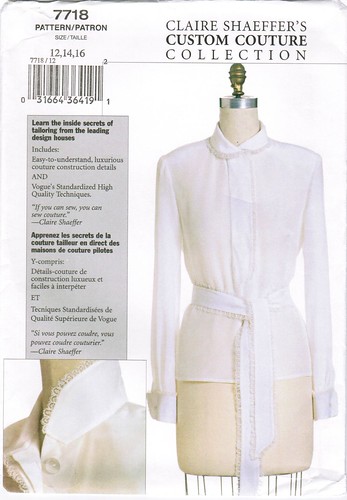
Vogue 8732
This is the latest edition to the collection; printed in 2011 and is rated average for difficulty. What girl couldn't use a jacket like this?

Vogue 7658
This is your basic mock wrap dress but the design is in the details. This pattern is rated average for difficulty and was printed in 2002.

Vogue 7634
Printed in 2002, this is the purple velvet coat that many have drooled over. Heck, I might even make it in purple! This pattern was printed in 2002 and is rated average for difficulty.

The most difficult patterns to find (in my size anyway) were #7634, #7658, and #7718. Every other pattern is readily available on eBay or for sale in a sewing forum somewhere. I stumbled upon these 3 patterns in a Yahoo group for selling sewing-related items. I ran a quick search for Claire Shaeffer items and found a very old post advertising these 3 patterns for $5.00 each. (Yes, I know. I basically stole them.) I contacted the seller and she still had these patterns more than a year later. In less than a week, my search was finally over.
So which pattern from the entire collection is my favorite?
It has to be #8333. That was my first purchase and what prompted me to buy the whole collection. I love a smartly tailored jacket and the pocket detail is so great.
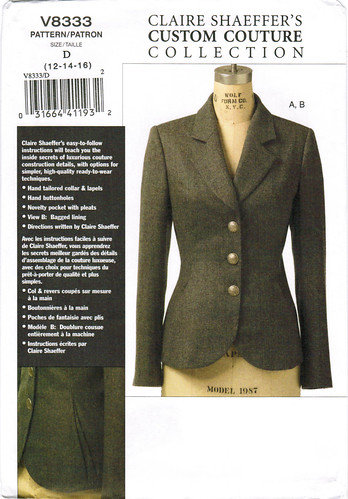
My least favorite has to be the skirt. I hate the color but once I put that aside, my eyes are immediately drawn to the gathers at the waistband. Not sleek and modern at all but maybe the gathers will hide my belly. (Or maybe I should just stop eating so much Mint Oreo ice cream. YUM!)
Vogue 7803
This pattern is rated average for difficulty and was printed in 2003. Oh, yeah. And the color is awful.
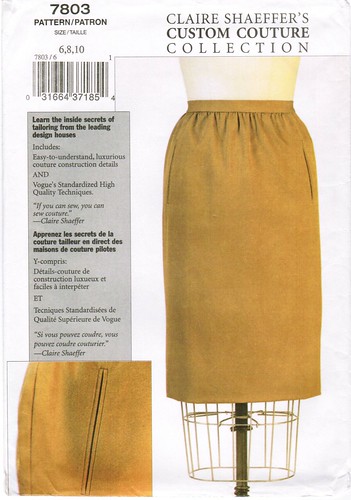
On a side note, some people have asked why I haven't been posting. Honestly, I'm flattered that anyone is reading this often enough to notice that I'm slacking at blogging. I've had many balls in the air. Some are things I want to do and some are things I have to do. Like find a job, for instance--don't want to do it. This economy is just awful. I was blind to how bad it was when I was employed. DH and I had been paying down debt and building up savings for quite some time so I was sheltered from the impact of a bad economy. Now that I don't have a job, my bank account balances have been on my mind daily. I've decided to take matters into my own hands. I've applied for at least 50 jobs...seriously. I've had 3 interviews. I'm fed up with trying to make others see my worth, my value as a potential employee. What's worse is I haven't enjoyed my work for the last 4-5 years anyway. I've contemplated starting my own sewing business for several years now. I'm finally putting this plan into action. It will be in baby steps but I feel a sense of relief knowing that one day in the forseeable future, I don't have to answer to anyone but myself AND I will love my job. An added bonus, my husband is proud of me for following my dreams. He's a keeper!
So that's what I've been up to lately. I spent yesterday refolding and organizing my entire fabric stash. I know, it's a little obsessive-compulsive but it gets the creative juices flowing. I have 2 very large piles of fabric prepped for cutting and projects picked out for all of them (mostly totes, clutches, knit tops, and pajamas). Next up is pattern alterations and cutting out the fabric. I'm in my happy place right now.
May your happy place be in your sewing room (without interruption from pets and husbands)!
--Julie
The final patterns to complete the collection are:
Vogue 7718
This pattern is rated for average difficulty and it was printed in 2003. Not exactly a top I would wear but maybe a different fabric could make it more modern-looking.

Vogue 8732
This is the latest edition to the collection; printed in 2011 and is rated average for difficulty. What girl couldn't use a jacket like this?

Vogue 7658
This is your basic mock wrap dress but the design is in the details. This pattern is rated average for difficulty and was printed in 2002.

Vogue 7634
Printed in 2002, this is the purple velvet coat that many have drooled over. Heck, I might even make it in purple! This pattern was printed in 2002 and is rated average for difficulty.

The most difficult patterns to find (in my size anyway) were #7634, #7658, and #7718. Every other pattern is readily available on eBay or for sale in a sewing forum somewhere. I stumbled upon these 3 patterns in a Yahoo group for selling sewing-related items. I ran a quick search for Claire Shaeffer items and found a very old post advertising these 3 patterns for $5.00 each. (Yes, I know. I basically stole them.) I contacted the seller and she still had these patterns more than a year later. In less than a week, my search was finally over.
So which pattern from the entire collection is my favorite?
It has to be #8333. That was my first purchase and what prompted me to buy the whole collection. I love a smartly tailored jacket and the pocket detail is so great.

My least favorite has to be the skirt. I hate the color but once I put that aside, my eyes are immediately drawn to the gathers at the waistband. Not sleek and modern at all but maybe the gathers will hide my belly. (Or maybe I should just stop eating so much Mint Oreo ice cream. YUM!)
Vogue 7803
This pattern is rated average for difficulty and was printed in 2003. Oh, yeah. And the color is awful.

On a side note, some people have asked why I haven't been posting. Honestly, I'm flattered that anyone is reading this often enough to notice that I'm slacking at blogging. I've had many balls in the air. Some are things I want to do and some are things I have to do. Like find a job, for instance--don't want to do it. This economy is just awful. I was blind to how bad it was when I was employed. DH and I had been paying down debt and building up savings for quite some time so I was sheltered from the impact of a bad economy. Now that I don't have a job, my bank account balances have been on my mind daily. I've decided to take matters into my own hands. I've applied for at least 50 jobs...seriously. I've had 3 interviews. I'm fed up with trying to make others see my worth, my value as a potential employee. What's worse is I haven't enjoyed my work for the last 4-5 years anyway. I've contemplated starting my own sewing business for several years now. I'm finally putting this plan into action. It will be in baby steps but I feel a sense of relief knowing that one day in the forseeable future, I don't have to answer to anyone but myself AND I will love my job. An added bonus, my husband is proud of me for following my dreams. He's a keeper!
So that's what I've been up to lately. I spent yesterday refolding and organizing my entire fabric stash. I know, it's a little obsessive-compulsive but it gets the creative juices flowing. I have 2 very large piles of fabric prepped for cutting and projects picked out for all of them (mostly totes, clutches, knit tops, and pajamas). Next up is pattern alterations and cutting out the fabric. I'm in my happy place right now.
May your happy place be in your sewing room (without interruption from pets and husbands)!
--Julie
Monday, May 2, 2011
Claire Shaeffer's Pattern Collection
I've been collecting these for the past 2 years. There are still a few out-of-print patterns I don't have but I wanted to share the ones I do have with you. Each pattern highlights a few couture techniques. With the exception of a few of these, I can see myself wearing them if made up in the right fabric. My plan is to one day have made up all of these patterns. Contrary to popular belief that "couture" equals "difficult", a few of these patterns are rated "easy", some "advanced" but most are "average." Of course, that doesn't rate the amount of time it will take to complete a garment.
#7467 OOP
I call this one the 80's jacket. Printed in 2001, this is the only pattern in my collection that uses both sew-in hair canvas and batiste for interfacing. This jacket uses pad stitching, welt and patch pockets, sleeve interfacing and shaping, and a 2-piece vented sleeve.

#7468 OOP (available online at Vogue Patterns)
Printed in 2001, this pants pattern is a double-pleated, straight leg pant with a mock fly zipper, side front pockets, and a button-front waistband.
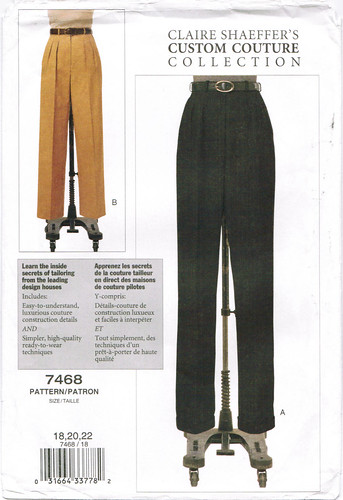
#7539 OOP
Printed in 2002, this very loose-fit jacket includes great instructions for using stay tape (couture "stay tape", where to put it and how it affects the way the garment hangs). I also found a great tip for pressing perfect seams in wool fabrics. I would love to have this jacket in the pink plaid fabric that Claire Shaeffer used.
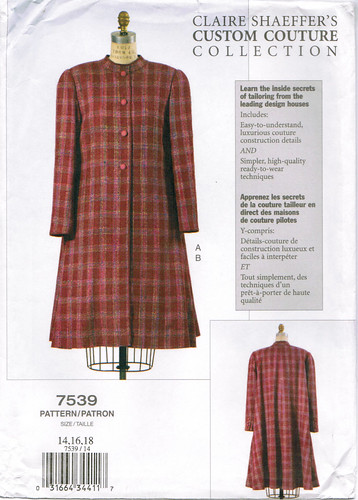
#7540 OOP
Printed in 2002, a straight dress with welt pockets that is fully underlined. This pattern includes instructions for making dress shields, a belt and hand buttonholes, interfaced hem, handpicked zipper and covered snaps.
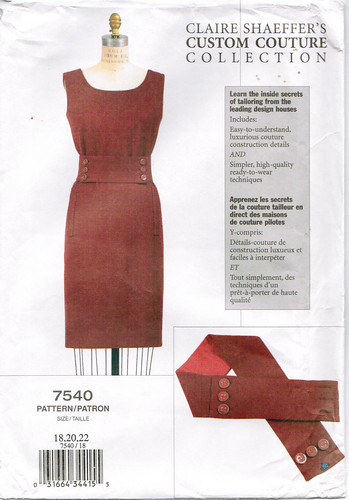
#7881 (currently available)
Printed in 2004, this is great pant has no darts (shape the fabric with steam), a mock-fly, and faced contour yoke.
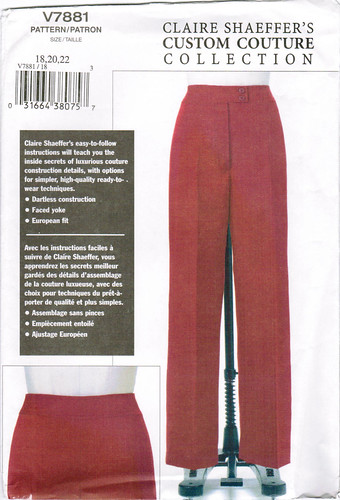
#7908 OOP (available online at Vogue Patterns)
Printed in 2004, this is a beautiful fitted jacket with an interesting pocket design. The instructions also include details about balanced darts and lapped seams. This jacket has a 2-piece sleeve and includes pad stitching, reinforcement for corners and curved edges, more advanced pressing techniques and hand buttonholes. I think the unusual pocket design is the reason for the advanced difficulty rating.
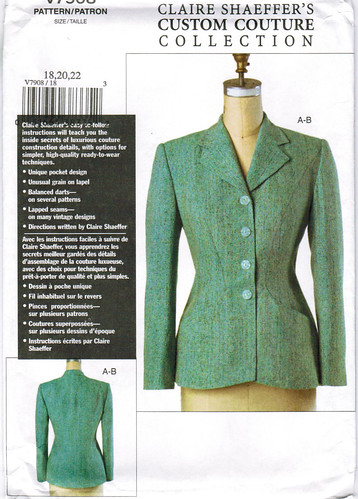
#7966 OOP
Printed in 2004, this dress has a tucked princess design with split neck and handpicked zipper. The dress has dress shields and lingerie guards and is rated advanced difficulty.
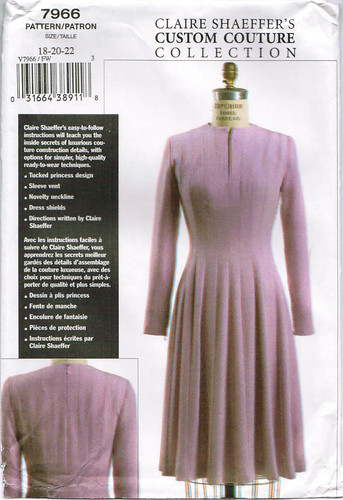
#8087 OOP (available online at Vogue Patterns)
Printed in 2005, this jacket is an advanced pattern. This jacket has pad stitching, welt pockets with flaps, and a 3-piece sleeve.

#8156 OOP
Printed in 2005, these straight-legged pants have a contour yoke, mock fly zipper, cuffed hem and back welt pocket with flap.
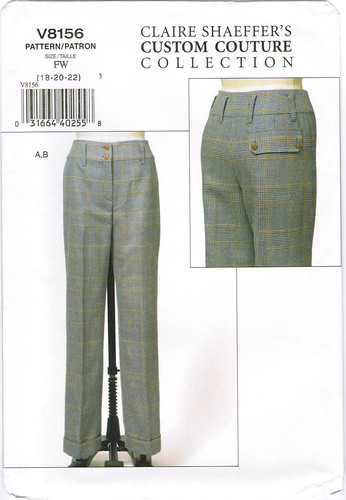
#8259 OOP
Printed in 2006, this pattern is rated difficult and often used for French jackets, aka the "Chanel jacket." Claire Shaeffer gives instructions for a 3-piece sleeve, quilting fabrics together, and a stand collar.
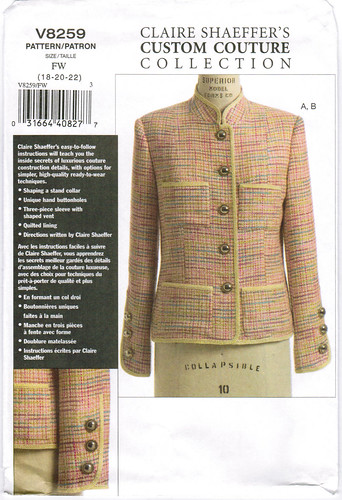
#8333 (currently available)
Printed in 2006, this is the pattern that first caught my attention in the Claire Shaeffer collection. I was more intrigued by the jacket and unusual pockets (hidden in the pleats) than learning couture techniques. This pattern is rated advanced difficulty and includes interfaced hem, 2-piece sleeve, pad stitching, sleeve head, and hand buttonholes.

#8369 OOP (available online at Vogue Patterns)
Printed in 2007, you finally learn how to add chain weight in the hemline (this is for you Chanel ladies out there). You also learn how to make Chinese ball buttons, insert a sleeve head, and interface a hem; jacket has a 2-piece sleeve.

#8400 OOP (available online at Vogue Patterns)
I call this the clown jacket. Printed in 2007, the fabric is very off-putting in this jacket and the instructions only explain one new technique, a bound buttonhole.

#8428 OOP (available online at Vogue Patterns)
Printed in 2007, this jacket pattern includes instructions for pad stitching, bias tubing, hand buttonholes, interfaced hem, 2-piece sleeve and sleeve heads.
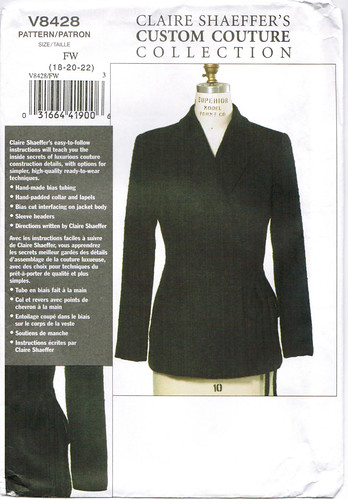
#8449 (currently available)
Printed in 2007, this is the first pattern that has better pictures showing you how to do the hand stitches. You also learn several bias techniques (like lap basting), bound zipper placket, and tons of practice with staying edges. This dress is not lined.
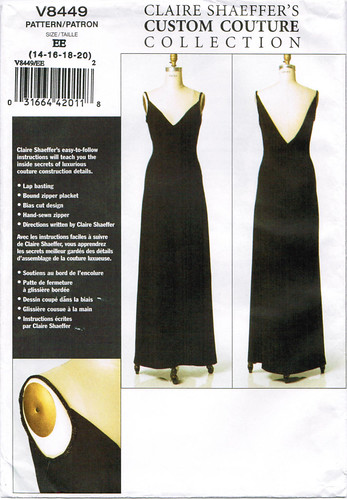
#8481 OOP
Printed in 2008, this jacket pattern is rated advanced difficulty. It includes pad stitching, quilted lining, 3-piece sleeve, hand buttonhole, and sleeve heads. Skimming the instructions, I don't see why this is an advanced pattern or why the lining is quilted. I've also noticed that all of the patterns with sleeve head instructions don't indicate what will be used for the sleeve head (in the instructions or on the back of the envelope), except for one. Sleeve heads were made of lambswool in haute couture but you can improvise with fleece or wool/cotton batting. I've seen them sold at tailoring shops with 2 pieces of muslin and polyester batting sandwiched in between.
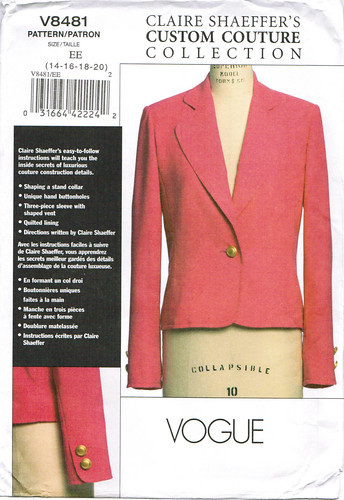
#8498 (currently available)
Printed in 2008, this pants pattern uses a French fly, pleat stays, inseam pocket, and "straight fold over" (or what I've always known as "cut-on") waistband that is interfaced with either double grosgrain ribbon, double hair canvas or single Petersham ribbon. There are also instructions for hanging loops and weighted hems.
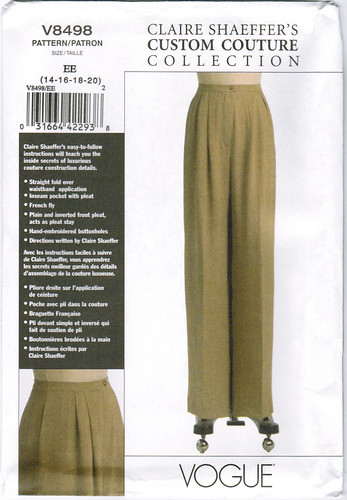
#8519 (currently available)
Printed in 2008, the sharp look of this jacket caught my eye. Looking more closely at the instructions reveals some new techniques, such as reverse corners and curves. The buttonhole is placed in the center front seam. This is the first pattern to indicate on the envelope that you need lambswool for the sleeve head. This pattern is rated advanced difficulty.

#8578 OOP (available online at Vogue Patterns)
Printed in 2009, this is the only pattern designed for knits. China silk is the interfacing for this garment. The "bias waist stay" is actually an elastic waistband enclosed. There are also waist pleats and inside corners to navigate.

#8621 (currently available)
Printed in 2009, this jacket pattern has an interesting design detail. The sleeve is raglan in back and set-in on the front. I can't even wrap my head around this idea. The jacket has a keyhole neckline, bound buttonholes, welt pockets, and a waist seam (no special treatment for this detail).
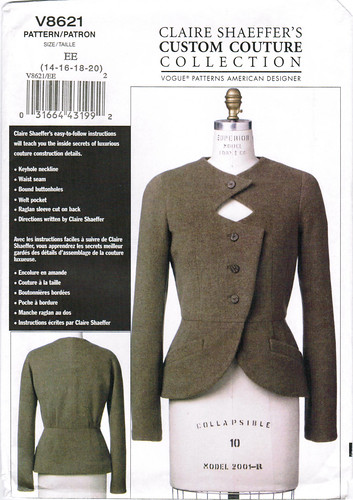
#8652 (currently available)
Printed in 2010, this pant has a bound buttonhole, French fly, cut-on or straight fold-over waistband with grosgrain or Petersham ribbon for interfacing and a partial lining (only to knees). The instructions have great drawings for all the hand stitches (why doesn't each pattern in this line has such great drawings?). These pants are rated easy for difficulty.
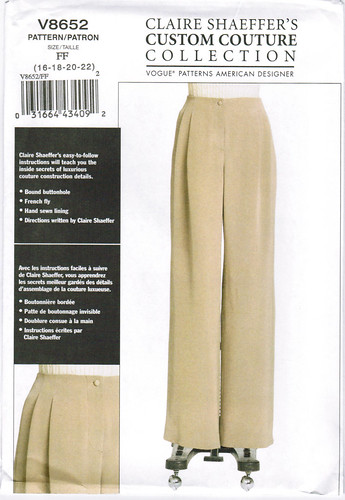
#8692 (currently available)
Printed in 2010, this jacket has interesting bust darts and the usual welt pockets, bound buttonholes, and 2-piece sleeve. No collar stand but the collar and lapel supposedly have some "interesting edgestitching." This pattern is rated advanced difficulty.

#8732 (currently available)
Printed in 2011, this is the newest addition to the collection. This unlined jacket pattern has welt pockets with flaps, padstitching, hand buttonholes, 1-piece sleeve, and interfaced hem.
pic 8732
There at least 3 other out-of-print Vogue Claire Shaeffer Custom Couture patterns missing from my stash but otherwise complete.
#7467 OOP
I call this one the 80's jacket. Printed in 2001, this is the only pattern in my collection that uses both sew-in hair canvas and batiste for interfacing. This jacket uses pad stitching, welt and patch pockets, sleeve interfacing and shaping, and a 2-piece vented sleeve.

#7468 OOP (available online at Vogue Patterns)
Printed in 2001, this pants pattern is a double-pleated, straight leg pant with a mock fly zipper, side front pockets, and a button-front waistband.

#7539 OOP
Printed in 2002, this very loose-fit jacket includes great instructions for using stay tape (couture "stay tape", where to put it and how it affects the way the garment hangs). I also found a great tip for pressing perfect seams in wool fabrics. I would love to have this jacket in the pink plaid fabric that Claire Shaeffer used.

#7540 OOP
Printed in 2002, a straight dress with welt pockets that is fully underlined. This pattern includes instructions for making dress shields, a belt and hand buttonholes, interfaced hem, handpicked zipper and covered snaps.

#7881 (currently available)
Printed in 2004, this is great pant has no darts (shape the fabric with steam), a mock-fly, and faced contour yoke.

#7908 OOP (available online at Vogue Patterns)
Printed in 2004, this is a beautiful fitted jacket with an interesting pocket design. The instructions also include details about balanced darts and lapped seams. This jacket has a 2-piece sleeve and includes pad stitching, reinforcement for corners and curved edges, more advanced pressing techniques and hand buttonholes. I think the unusual pocket design is the reason for the advanced difficulty rating.

#7966 OOP
Printed in 2004, this dress has a tucked princess design with split neck and handpicked zipper. The dress has dress shields and lingerie guards and is rated advanced difficulty.

#8087 OOP (available online at Vogue Patterns)
Printed in 2005, this jacket is an advanced pattern. This jacket has pad stitching, welt pockets with flaps, and a 3-piece sleeve.

#8156 OOP
Printed in 2005, these straight-legged pants have a contour yoke, mock fly zipper, cuffed hem and back welt pocket with flap.

#8259 OOP
Printed in 2006, this pattern is rated difficult and often used for French jackets, aka the "Chanel jacket." Claire Shaeffer gives instructions for a 3-piece sleeve, quilting fabrics together, and a stand collar.

#8333 (currently available)
Printed in 2006, this is the pattern that first caught my attention in the Claire Shaeffer collection. I was more intrigued by the jacket and unusual pockets (hidden in the pleats) than learning couture techniques. This pattern is rated advanced difficulty and includes interfaced hem, 2-piece sleeve, pad stitching, sleeve head, and hand buttonholes.

#8369 OOP (available online at Vogue Patterns)
Printed in 2007, you finally learn how to add chain weight in the hemline (this is for you Chanel ladies out there). You also learn how to make Chinese ball buttons, insert a sleeve head, and interface a hem; jacket has a 2-piece sleeve.

#8400 OOP (available online at Vogue Patterns)
I call this the clown jacket. Printed in 2007, the fabric is very off-putting in this jacket and the instructions only explain one new technique, a bound buttonhole.

#8428 OOP (available online at Vogue Patterns)
Printed in 2007, this jacket pattern includes instructions for pad stitching, bias tubing, hand buttonholes, interfaced hem, 2-piece sleeve and sleeve heads.

#8449 (currently available)
Printed in 2007, this is the first pattern that has better pictures showing you how to do the hand stitches. You also learn several bias techniques (like lap basting), bound zipper placket, and tons of practice with staying edges. This dress is not lined.

#8481 OOP
Printed in 2008, this jacket pattern is rated advanced difficulty. It includes pad stitching, quilted lining, 3-piece sleeve, hand buttonhole, and sleeve heads. Skimming the instructions, I don't see why this is an advanced pattern or why the lining is quilted. I've also noticed that all of the patterns with sleeve head instructions don't indicate what will be used for the sleeve head (in the instructions or on the back of the envelope), except for one. Sleeve heads were made of lambswool in haute couture but you can improvise with fleece or wool/cotton batting. I've seen them sold at tailoring shops with 2 pieces of muslin and polyester batting sandwiched in between.

#8498 (currently available)
Printed in 2008, this pants pattern uses a French fly, pleat stays, inseam pocket, and "straight fold over" (or what I've always known as "cut-on") waistband that is interfaced with either double grosgrain ribbon, double hair canvas or single Petersham ribbon. There are also instructions for hanging loops and weighted hems.

#8519 (currently available)
Printed in 2008, the sharp look of this jacket caught my eye. Looking more closely at the instructions reveals some new techniques, such as reverse corners and curves. The buttonhole is placed in the center front seam. This is the first pattern to indicate on the envelope that you need lambswool for the sleeve head. This pattern is rated advanced difficulty.

#8578 OOP (available online at Vogue Patterns)
Printed in 2009, this is the only pattern designed for knits. China silk is the interfacing for this garment. The "bias waist stay" is actually an elastic waistband enclosed. There are also waist pleats and inside corners to navigate.

#8621 (currently available)
Printed in 2009, this jacket pattern has an interesting design detail. The sleeve is raglan in back and set-in on the front. I can't even wrap my head around this idea. The jacket has a keyhole neckline, bound buttonholes, welt pockets, and a waist seam (no special treatment for this detail).

#8652 (currently available)
Printed in 2010, this pant has a bound buttonhole, French fly, cut-on or straight fold-over waistband with grosgrain or Petersham ribbon for interfacing and a partial lining (only to knees). The instructions have great drawings for all the hand stitches (why doesn't each pattern in this line has such great drawings?). These pants are rated easy for difficulty.

#8692 (currently available)
Printed in 2010, this jacket has interesting bust darts and the usual welt pockets, bound buttonholes, and 2-piece sleeve. No collar stand but the collar and lapel supposedly have some "interesting edgestitching." This pattern is rated advanced difficulty.

#8732 (currently available)
Printed in 2011, this is the newest addition to the collection. This unlined jacket pattern has welt pockets with flaps, padstitching, hand buttonholes, 1-piece sleeve, and interfaced hem.
pic 8732
There at least 3 other out-of-print Vogue Claire Shaeffer Custom Couture patterns missing from my stash but otherwise complete.
Sunday, May 1, 2011
10 Wardrobe Essentials
S.W.A.P. (sewing with a plan), 5-piece wardrobe, 10 essentials...all ways of creating pieces to build a versatile wardrobe so you don't have to stand in your closet and cry out "I have nothing to wear!"
I have read one of Tim Gunn's earlier books and decided it wasn't a keeper for my ever-expanding library of sewing and fashion. I am intrigued, however, by the idea of sewing with a goal in mind instead of randomly selecting pieces like I usually do. There aren't any real surprises on this 10 essentials list by Tim Gunn but I enjoy him on Project Runway so let's give him credit for a great list.
You can view the whole list on InStyle here.
Butterick 5321: With short sleeves, can be worn in warm weather and with a jacket for cooler temps or cold rooms. I wonder if the inverted pleat at the waist would be a good belly and hip minimizer.
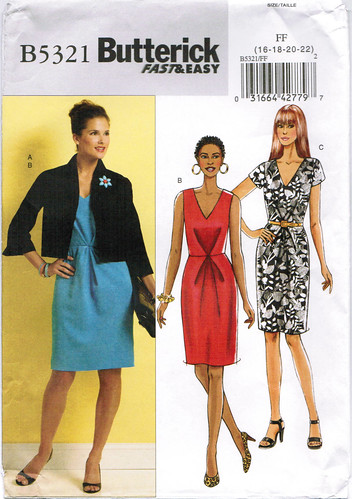
McCall's 5525: The classic trench, perhaps with the Peter Pan collar
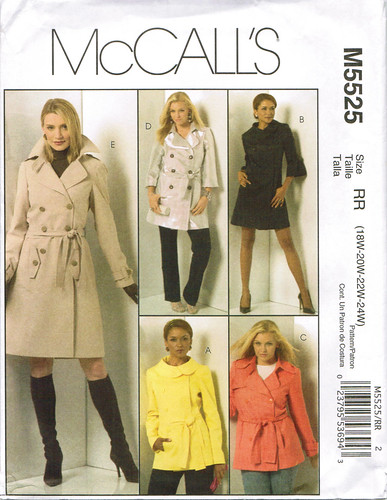
Vogue 7881: classic dress pants

Simplicity 2367: Skirt in an interesting fabric or a solid with some contrasting topstitching

Burda 7618: Not THE essential blazer but in the right fabric, this jacket could be quite versatile.
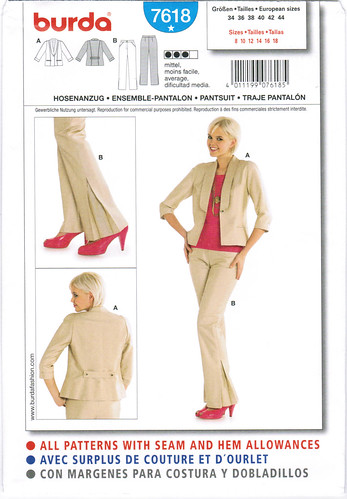
New Look 6598: I've had this pattern for many years. This pattern deserves better than to waste away in my stash.
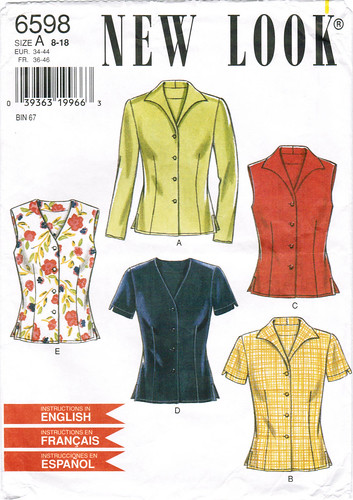
Simplicity 2403: Not the double-breasted version
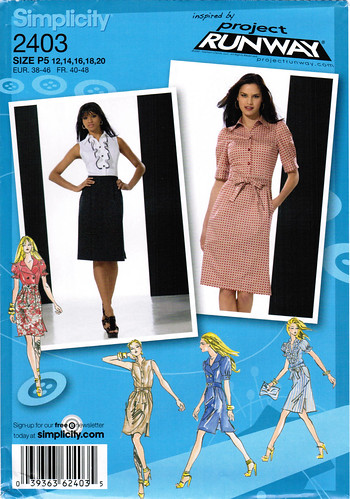
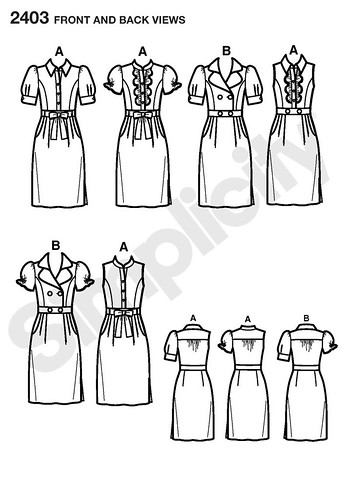
Vogue 1034
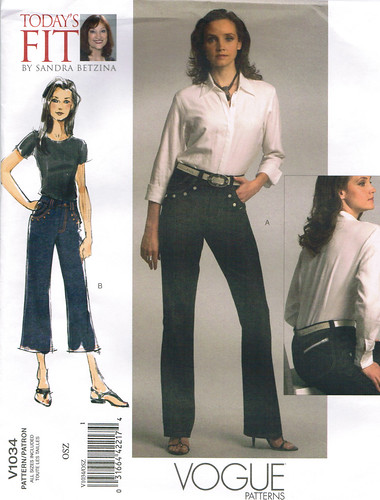
For my alternative to sweatpants: I think I actually need 2 kinds of alternatives. One type of outfit that I could run out to the store in and not look like a bum. Another type for lounging around the house.
Alternative #1:
Vogue 1197

Alternative #2:
Butterick 5216: Views C and D can hide the belly and if I add some discrete coverage to the front bodice, I can skip the bra. Bras are evil.
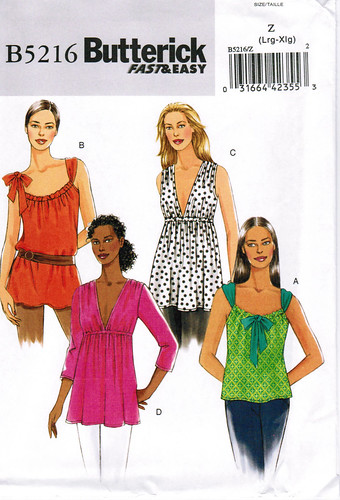
Simplicity 2367: The pants or capris

Of course, the essentials only work if you have the right accessories. This is where I am in need of serious help. Tackling one area at a time....
I have read one of Tim Gunn's earlier books and decided it wasn't a keeper for my ever-expanding library of sewing and fashion. I am intrigued, however, by the idea of sewing with a goal in mind instead of randomly selecting pieces like I usually do. There aren't any real surprises on this 10 essentials list by Tim Gunn but I enjoy him on Project Runway so let's give him credit for a great list.
You can view the whole list on InStyle here.
- Little Black Dress: I don't have one. I know, it's shameful. Every time DH says we have an event to go to, I fail to plan ahead and then find myself at said event wishing I had a basic black dress to wear for these occasions.
- Trench Coat: I actually have a beautiful trench I bought several years ago but it no longer fits. Darn coat must have shrunk.... Oh well, time for another.
- Classic Dress Pants: I have 3 pairs I purchased from Eddie Bauer some time ago. I'm slowly getting around to hemming them. They are nice and fit pretty well but I want a perfectly fitting pair of pants so I'll add these to the list.
- Versatile Skirt: What instantly comes to mind is a basic skirt, solid color or very subtle pattern. After looking at Tim Gunn's selection, I see that an interesting pattern would be a better choice. A statement skirt.
- Fitted Blazer: As I am currently going on job interviews, I needed a jacket that fit superbly and I needed it now. I was shocked to find some RTW jackets that fit beautifully. Jones New York, I should've known. I've always admired the look of their jackets. I do have a smart-looking Vogue Claire Shaeffer Custom Couture pattern I've been dying to make so now's the time.
- Classic White Shirt: I LOVE white shirts! Tees, button-downs, doesn't matter; white looks great next to my skin.
- Day Dress: Tim says this is not a cocktail dress alternative; more like a shift, wrap or shirt dress. I have several fantastic shirt dress patterns and a few knit wraps that I'd love to make.
- Cashmere Sweater: Can't sew this one...or can I? I see great sweater knits online all the time. I did have a cashmere sweater once and I wore it at least once a week. Cashmere has the bonus of being as soft as angora without covering you with hair.
- Perfect-Fit Jeans: Amen to that! This may be my holy grail if I could ever find or make a pair.
- Alternative to the Sweatsuit: "Casual with sophistication." I have to think about this for a bit. I don't wear sweatsuits but I have some black knit pants and baggy T-shirts that are so comfortable. What would be as comfortable and significantly more flattering?
Butterick 5321: With short sleeves, can be worn in warm weather and with a jacket for cooler temps or cold rooms. I wonder if the inverted pleat at the waist would be a good belly and hip minimizer.

McCall's 5525: The classic trench, perhaps with the Peter Pan collar

Vogue 7881: classic dress pants

Simplicity 2367: Skirt in an interesting fabric or a solid with some contrasting topstitching

Burda 7618: Not THE essential blazer but in the right fabric, this jacket could be quite versatile.

New Look 6598: I've had this pattern for many years. This pattern deserves better than to waste away in my stash.

Simplicity 2403: Not the double-breasted version


Vogue 1034

For my alternative to sweatpants: I think I actually need 2 kinds of alternatives. One type of outfit that I could run out to the store in and not look like a bum. Another type for lounging around the house.
Alternative #1:
Vogue 1197

Alternative #2:
Butterick 5216: Views C and D can hide the belly and if I add some discrete coverage to the front bodice, I can skip the bra. Bras are evil.

Simplicity 2367: The pants or capris

Of course, the essentials only work if you have the right accessories. This is where I am in need of serious help. Tackling one area at a time....
Sunday, April 24, 2011
Sewing groups
Do you belong to one? I always shunned these before. I figured they were full of women talking about kids and quilts. Neither of which interested me. Now I'm the president of the local chapter of the American Sewing Guild. Clearly I've changed my opinion about sewing groups. What did it? Well, maturity for one. I'm in my 30's now and find myself much more open to trying new things without making assumptions first.
Probably the most significant event that changed my mind...I signed up for a week-long sewing class. Some of you may remember my Nashville Chanel and wrecked car, that is the very week I am referring to. The class consisted of 10 women, all but one of them older than me. We had very different backgrounds...pilot, court reporter, nurse, small business owner, fashion design instructor, etc. We all had very different skill levels and goals for the class...make a bias skirt that doesn't have wonky seams, design a complex dress from scratch, make a date-night dress for evenings with the hubby, and for me, just learn something new. I didn't even have a project of my own to do. I asked a friend if I could make one of her Victorian dresses for her because I wanted a complex project that would allow me to learn the most. If you've read this blog in the past, you know that dress never materialized but I did start a classic French jacket that makes me feel like a talented seamstress and smart, successful woman. Not too shabby for not having a clear goal upfront.
I was nervous about signing up for this class. I have solid basic skills but hadn't sewn much over the last 10 years. I figured a $1,000-class would bring in experienced seamstresses with expensive machines. I own 2 basic Singer machines: $150 mechanical one purchased at Target and my $400 commercial machine with a jet engine. No Bernina, Janome, Viking or Pfaff for me. When I showed up, I realized I did have the cheapest, least jazzy machine there. I also had the loudest machine. I was self-conscious at first but quickly realized no one cared. They even came by to look at my machine and learn about its features. Surely something that loud was interesting as well.
Over the course of the week I discovered I didn't feel nervous or out of place at all. I belonged right where I was at that moment. These ladies were fun, interesting and supportive. We each had very different styles but somehow found each other's project beautiful and wanted to learn more. Maybe we bonded over the fact that we each spent a buttload of money to be there. I think we bonded more so because we shared a common interest: wanting to improve our sewing skills and learn from others.
I've missed that group of women since the class ended. I also realized that I can prep, cut and sew much faster than I ever have. I'd like to believe the comaraderie got the creative juices flowing to the point that I didn't stop to doubt myself or think too much about the next step. Just do it.
The point of this long-winded rambling is I decided before moving from Memphis to Chattanooga that I wanted to join a sewing group. I was going to put aside the idea that all sewing groups are a bunch of older ladies making quilts and talking about kids. Problem was that Chattanooga didn't have a formal sewing group that I could find; no BurdaStyle Club, no American Sewing Guild (ASG) chapter, nothing. (I have since learned, now that I live here, that there are a few sewing groups around but they aren't that easy to find.) By contacting the ASG chapters surrounding Chattanooga, I found a few locals that were also interested in forming a chapter. So now I'm the president of the Chattanooga chapter of the ASG, go figure. And most of the ladies I've met are old enough to be my mother, and they talk about their kids, and they all quilt. And I love spending time with them. I even want to learn to quilt. They want to learn to make clothes. We inspire one another. Isn't that what sewing groups are really all about?
As the president of the local ASG chapter I extend an invitation to all those that sew. Young or old, beginner or advanced, those with fancy tools and those that bought their gadgets in the same store they bought toilet paper and apple juice. No matter if you only sew clothes, quilts, or slipcovers. All are invited because your companionship warms my heart. I want to know what you know. I want to see what you've made. You inspire me. I hope that I can inspire you as well.
The Chattanooga chapter of the American Sewing Guild will be meeting the 3rd Tuesday of every month (except in June) at 6:30 pm at St. John United Methodist Church (3921 Murray Hills Drive).
Our upcoming meetings are:
Probably the most significant event that changed my mind...I signed up for a week-long sewing class. Some of you may remember my Nashville Chanel and wrecked car, that is the very week I am referring to. The class consisted of 10 women, all but one of them older than me. We had very different backgrounds...pilot, court reporter, nurse, small business owner, fashion design instructor, etc. We all had very different skill levels and goals for the class...make a bias skirt that doesn't have wonky seams, design a complex dress from scratch, make a date-night dress for evenings with the hubby, and for me, just learn something new. I didn't even have a project of my own to do. I asked a friend if I could make one of her Victorian dresses for her because I wanted a complex project that would allow me to learn the most. If you've read this blog in the past, you know that dress never materialized but I did start a classic French jacket that makes me feel like a talented seamstress and smart, successful woman. Not too shabby for not having a clear goal upfront.
I was nervous about signing up for this class. I have solid basic skills but hadn't sewn much over the last 10 years. I figured a $1,000-class would bring in experienced seamstresses with expensive machines. I own 2 basic Singer machines: $150 mechanical one purchased at Target and my $400 commercial machine with a jet engine. No Bernina, Janome, Viking or Pfaff for me. When I showed up, I realized I did have the cheapest, least jazzy machine there. I also had the loudest machine. I was self-conscious at first but quickly realized no one cared. They even came by to look at my machine and learn about its features. Surely something that loud was interesting as well.
Over the course of the week I discovered I didn't feel nervous or out of place at all. I belonged right where I was at that moment. These ladies were fun, interesting and supportive. We each had very different styles but somehow found each other's project beautiful and wanted to learn more. Maybe we bonded over the fact that we each spent a buttload of money to be there. I think we bonded more so because we shared a common interest: wanting to improve our sewing skills and learn from others.
I've missed that group of women since the class ended. I also realized that I can prep, cut and sew much faster than I ever have. I'd like to believe the comaraderie got the creative juices flowing to the point that I didn't stop to doubt myself or think too much about the next step. Just do it.
The point of this long-winded rambling is I decided before moving from Memphis to Chattanooga that I wanted to join a sewing group. I was going to put aside the idea that all sewing groups are a bunch of older ladies making quilts and talking about kids. Problem was that Chattanooga didn't have a formal sewing group that I could find; no BurdaStyle Club, no American Sewing Guild (ASG) chapter, nothing. (I have since learned, now that I live here, that there are a few sewing groups around but they aren't that easy to find.) By contacting the ASG chapters surrounding Chattanooga, I found a few locals that were also interested in forming a chapter. So now I'm the president of the Chattanooga chapter of the ASG, go figure. And most of the ladies I've met are old enough to be my mother, and they talk about their kids, and they all quilt. And I love spending time with them. I even want to learn to quilt. They want to learn to make clothes. We inspire one another. Isn't that what sewing groups are really all about?
As the president of the local ASG chapter I extend an invitation to all those that sew. Young or old, beginner or advanced, those with fancy tools and those that bought their gadgets in the same store they bought toilet paper and apple juice. No matter if you only sew clothes, quilts, or slipcovers. All are invited because your companionship warms my heart. I want to know what you know. I want to see what you've made. You inspire me. I hope that I can inspire you as well.
The Chattanooga chapter of the American Sewing Guild will be meeting the 3rd Tuesday of every month (except in June) at 6:30 pm at St. John United Methodist Church (3921 Murray Hills Drive).
Our upcoming meetings are:
- May 17--Meet & Greet, Show & Tell (bring your current projects, UFOs, favorite fabric/book/notion, anything to share)
- June 14 (2nd Tuesday)--Paper Piecing demonstration
Saturday, April 23, 2011
A pathetic follow-up
It has been 13 days so time for an update.
- How many hours per day/week do you sew?
- What are you spending/wasting the rest of your free time on?
- When you do sew, how do you feel before, during and afterwards?
- What factors are you aware of that impact upon when you make time to sew?
- What are you learning about sewing productivity from this process, if anything? What tips can you share?
Subscribe to:
Posts (Atom)
Just my opinion....
This policy is valid from 11 December 2009
This blog is a personal blog written and edited by me. This blog does not accept any form of advertising, sponsorship, or paid insertions. We write for our own purposes. However, we may be influenced by our background, occupation, religion, political affiliation or experience.
The owner(s) of this blog will never receive compensation in any way from this blog.
The owner(s) of this blog is not compensated to provide opinion on products, services, websites and various other topics. The views and opinions expressed on this blog are purely the blog owners. If we claim or appear to be experts on a certain topic or product or service area, we will only endorse products or services that we believe, based on our expertise, are worthy of such endorsement. Any product claim, statistic, quote or other representation about a product or service should be verified with the manufacturer or provider.
This blog does not contain any content which might present a conflict of interest.
To get your own policy, go to http://www.disclosurepolicy.org
This blog is a personal blog written and edited by me. This blog does not accept any form of advertising, sponsorship, or paid insertions. We write for our own purposes. However, we may be influenced by our background, occupation, religion, political affiliation or experience.
The owner(s) of this blog will never receive compensation in any way from this blog.
The owner(s) of this blog is not compensated to provide opinion on products, services, websites and various other topics. The views and opinions expressed on this blog are purely the blog owners. If we claim or appear to be experts on a certain topic or product or service area, we will only endorse products or services that we believe, based on our expertise, are worthy of such endorsement. Any product claim, statistic, quote or other representation about a product or service should be verified with the manufacturer or provider.
This blog does not contain any content which might present a conflict of interest.
To get your own policy, go to http://www.disclosurepolicy.org